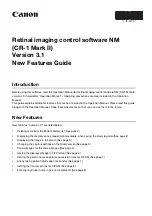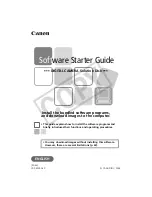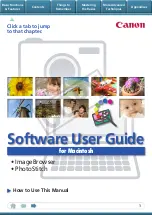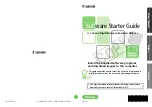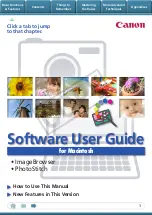
2:50
Volume 2, Part 1: Addressing and Protection
inserted TC entry may be occasionally removed before this point, and software
must be prepared to re-insert the TC entry on a subsequent fault. For example,
eager or mandatory RSE activity, speculative VHPT walks, or other interruptions of
the restart instruction may displace the software-inserted TC entry, but when
software later re-inserts the same TC entry, the processor must eventually
complete the restart instruction to ensure forward progress, even if that restart
instruction takes other faults which must be handled before it can complete. If
PSR.ic is set to 1 by instructions other than
rfi
, the processor does not guarantee
forward progress.
• If software inserts an entry into the TLB with an overlapping entry (same or larger
size) in the VHPT, and if the VHPT walker is enabled, forward progress is not
guaranteed.
See “VHPT Searching” on page 2:62.
• Software may only make references to memory with physical addresses or with
virtual addresses which are mapped with TRs, or to addresses mapped by the
just-inserted translation, between the insertion of a TC entry, and the execution of
the instruction with PSR.ic equal to 1 which is dependent on that entry for forward
progress. Software may also make repeated attempts to execute the same
instruction with PSR.ic equal to 1. If software makes any other memory references
than these, the processor does not guarantee forward progress.
• Software must not defeat forward progress by consistently displacing a required TC
entry through a global or local translation cache purge.
IA-32 code has more stringent forward progress rules that must be observed by the
processor and software. IA-32 forward progress rules are defined in
“IA-32 TLB Forward Progress Requirements” on page 2:261
.
The translation cache can be used to cache TR entries if the TC maintains the
instruction vs. data distinction that is required of the TRs. A data reference cannot be
satisfied by a TC entry that is a cache of an instruction TR entry, nor can an instruction
reference be satisfied by a TC entry that is a cache of a data TR entry. This approach
can be useful in a multi-level TLB implementation.
4.1.1.3
Unified Translation Lookaside Buffers
Some processor models may merge the ITC and DTC into a unified translation cache.
The minimum number of unified entries is 2 (1 for instruction, and 1 for data).
Processors may service instruction fetch memory references with TC entries originally
installed into the DTC and service data memory references with translations originally
installed in the ITC. To ensure consistent operation across processor implementations,
software is recommended to not install different translations into the ITC or DTC for the
same virtual region and virtual address. ITC inserts may remove DTC entries. DTC
inserts may remove ITC entries. TC purges remove ITC and DTC entries.
Instruction and data translation registers cannot be unified. DTR entries cannot be used
by instruction references and ITR entries cannot be used by data references. ITR
inserts and purges do not remove DTR entries. DTR inserts and purges do not remove
ITR entries.
Summary of Contents for ITANIUM ARCHITECTURE - SOFTWARE DEVELOPERS VOLUME 3 REV 2.3
Page 1: ......
Page 11: ...x Intel Itanium Architecture Software Developer s Manual Rev 2 3 ...
Page 13: ...1 2 Intel Itanium Architecture Software Developer s Manual Rev 2 3 ...
Page 33: ...1 22 Volume 1 Part 1 Introduction to the Intel Itanium Architecture ...
Page 57: ...1 46 Volume 1 Part 1 Execution Environment ...
Page 147: ...1 136 Intel Itanium Architecture Software Developer s Manual Rev 2 3 ...
Page 149: ...1 138 Volume 1 Part 2 About the Optimization Guide ...
Page 191: ...1 180 Volume 1 Part 2 Predication Control Flow and Instruction Stream ...
Page 230: ......
Page 248: ...236 Intel Itanium Architecture Software Developer s Manual Rev 2 3 ...
Page 250: ...2 2 Intel Itanium Architecture Software Developer s Manual Rev 2 3 ...
Page 264: ...2 16 Volume 2 Part 1 Intel Itanium System Environment ...
Page 380: ...2 132 Volume 2 Part 1 Interruptions ...
Page 398: ...2 150 Volume 2 Part 1 Register Stack Engine ...
Page 486: ...2 238 Volume 2 Part 1 IA 32 Interruption Vector Descriptions ...
Page 750: ...2 502 Intel Itanium Architecture Software Developer s Manual Rev 2 3 ...
Page 754: ...2 506 Volume 2 Part 2 About the System Programmer s Guide ...
Page 796: ...2 548 Volume 2 Part 2 Interruptions and Serialization ...
Page 808: ...2 560 Volume 2 Part 2 Context Management ...
Page 842: ...2 594 Volume 2 Part 2 Floating point System Software ...
Page 850: ...2 602 Volume 2 Part 2 IA 32 Application Support ...
Page 862: ...2 614 Volume 2 Part 2 External Interrupt Architecture ...
Page 870: ...2 622 Volume 2 Part 2 Performance Monitoring Support ...
Page 891: ......
Page 1099: ...3 200 Volume 3 Instruction Reference padd Interruptions Illegal Operation fault ...
Page 1295: ...3 396 Volume 3 Resource and Dependency Semantics ...
Page 1296: ......
Page 1302: ...402 Intel Itanium Architecture Software Developer s Manual Rev 2 3 ...
Page 1494: ...4 192 Volume 4 Base IA 32 Instruction Reference FWAIT Wait See entry for WAIT ...
Page 1647: ...Volume 4 Base IA 32 Instruction Reference 4 345 ROL ROR Rotate See entry for RCL RCR ROL ROR ...
Page 1884: ...4 582 Volume 4 IA 32 SSE Instruction Reference ...
Page 1885: ...Index Intel Itanium Architecture Software Developer s Manual Rev 2 3 Index ...
Page 1886: ...Index Intel Itanium Architecture Software Developer s Manual Rev 2 3 ...
Page 1898: ...INDEX Index 12 Index for Volumes 1 2 3 and 4 ...































